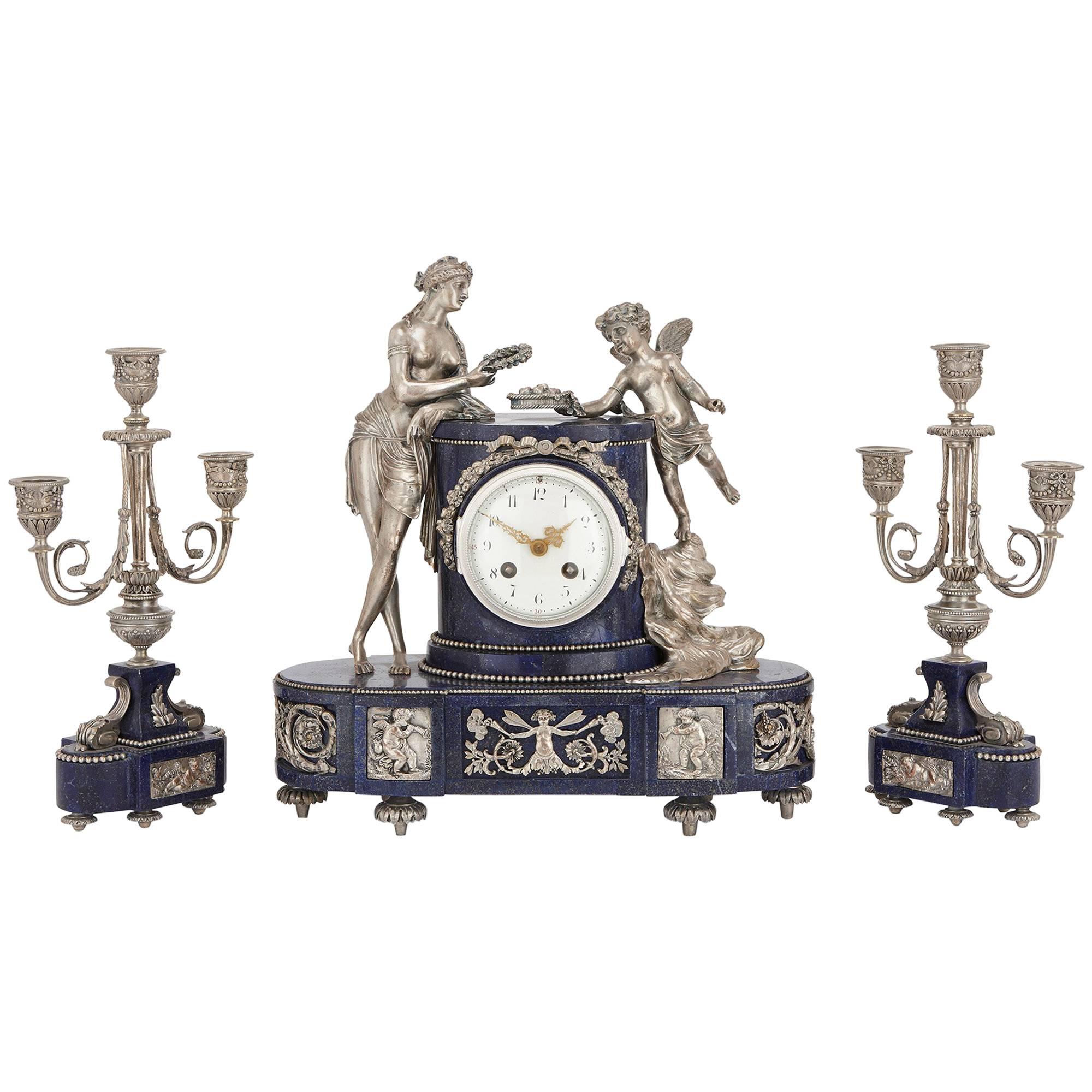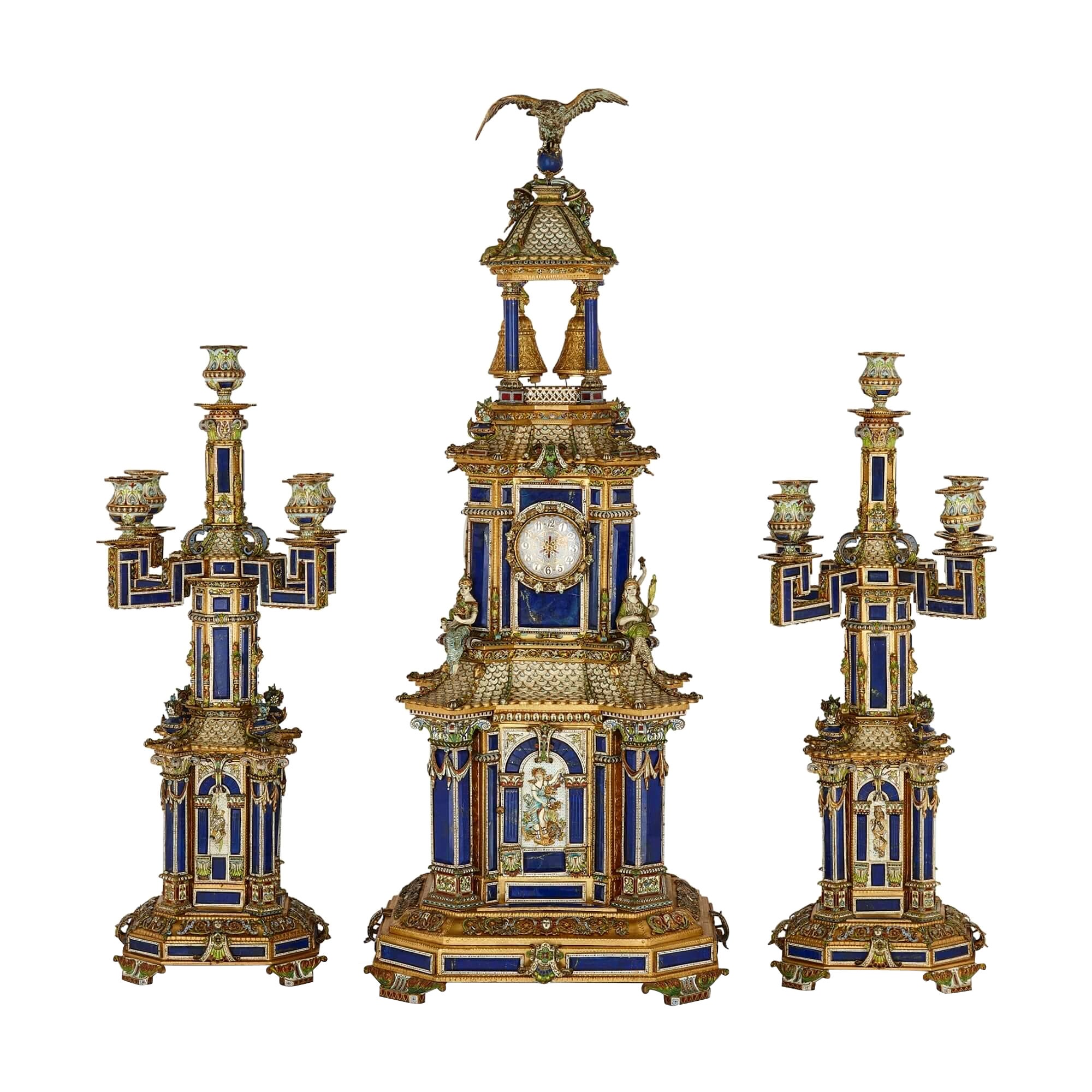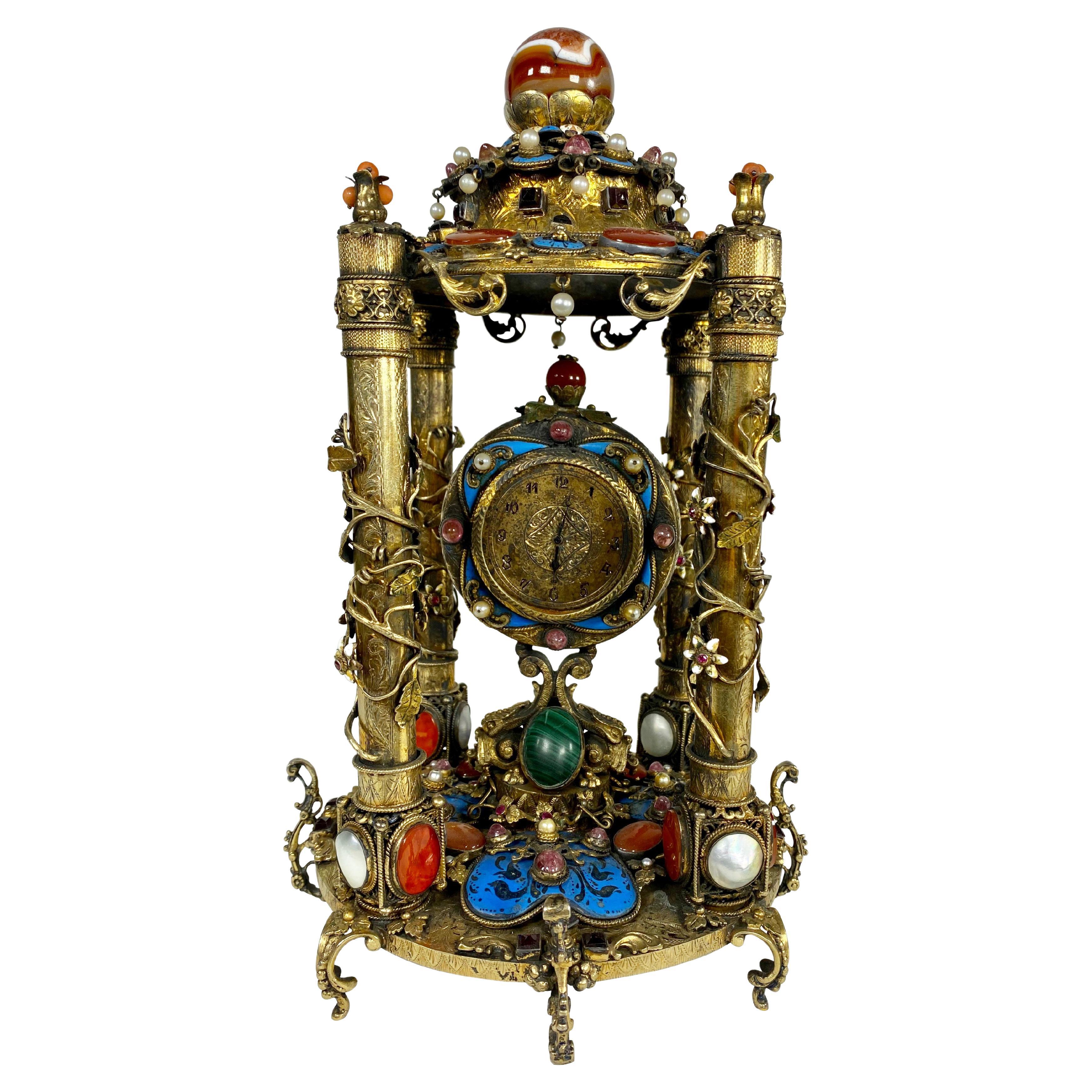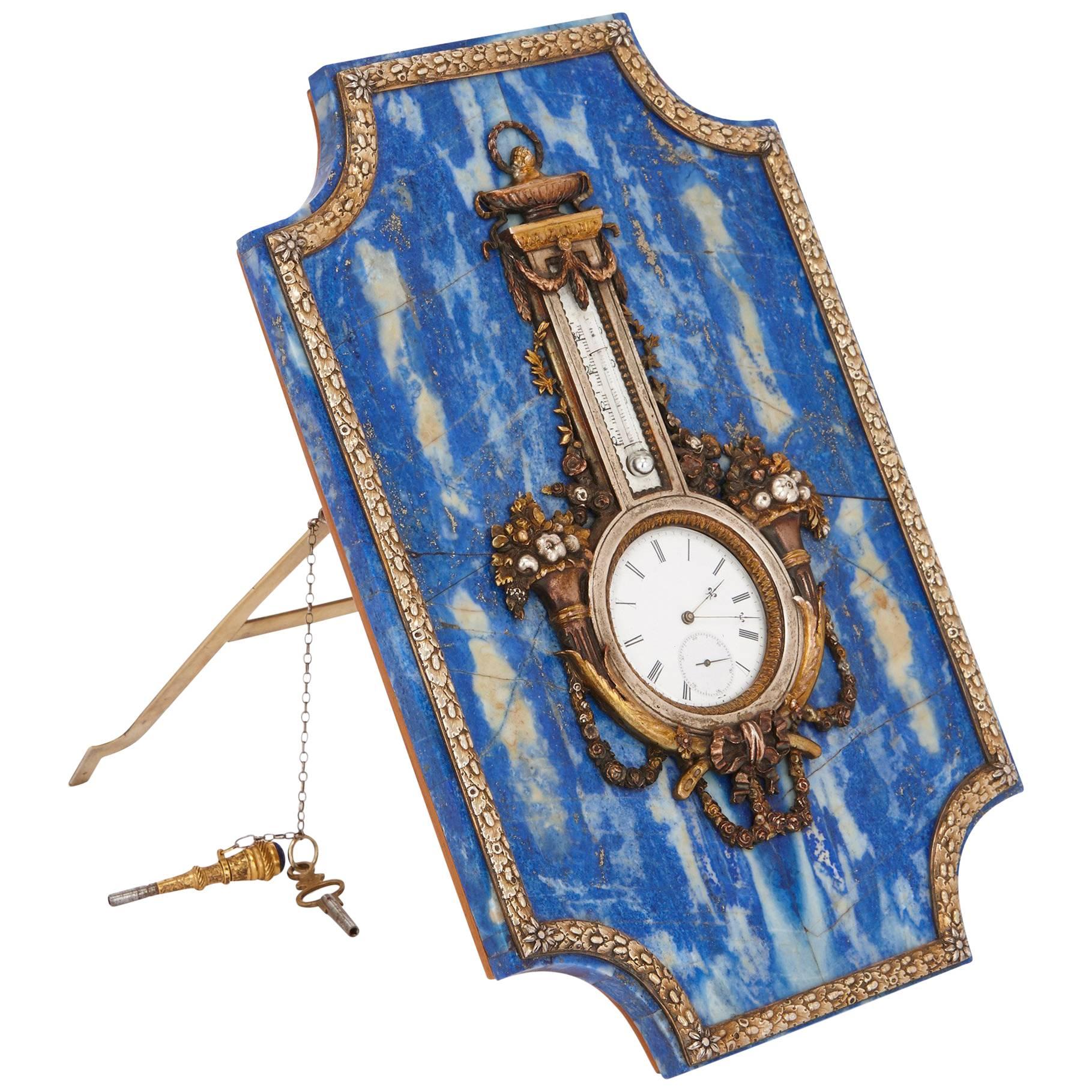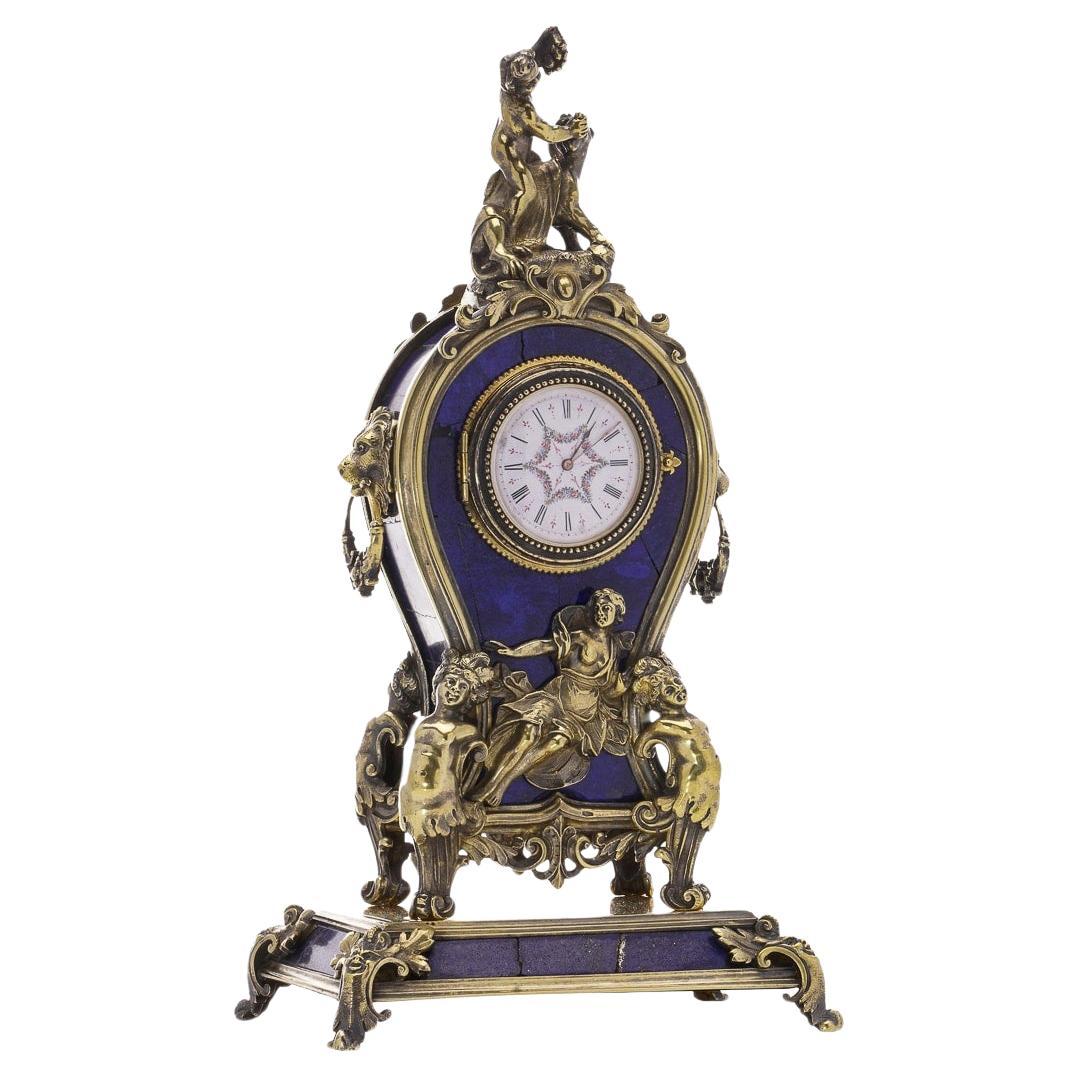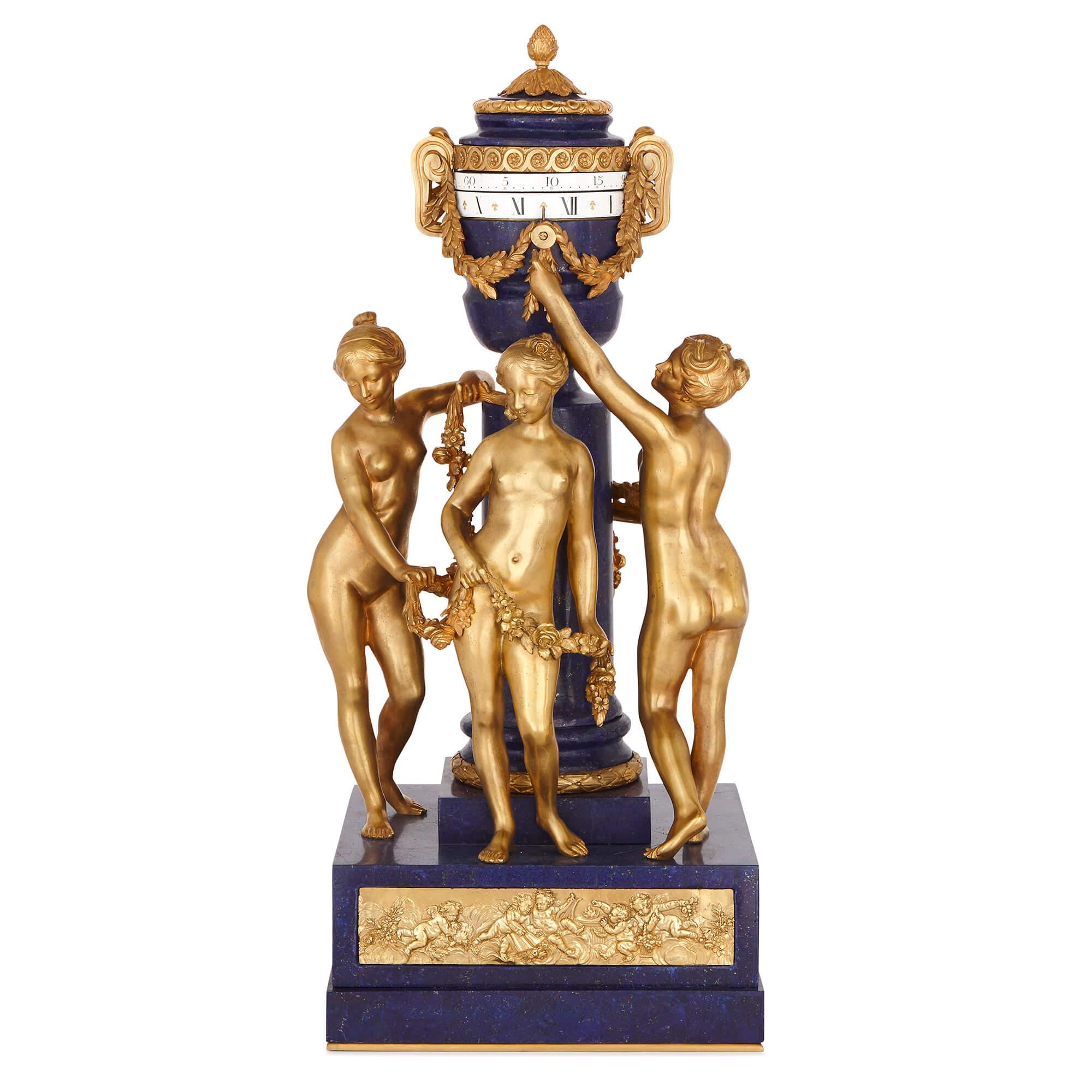Items Similar to Antique Austro-Hungarian 800 Silver and Lapis Lazuli Clock
Want more images or videos?
Request additional images or videos from the seller
1 of 11
Antique Austro-Hungarian 800 Silver and Lapis Lazuli Clock
About the Item
Step into the enchanting world of time with our Antique Austro-Hungarian 800 Silver and Lapis Lazuli Clock.
An opulent masterpiece that transcends the ordinary, weaving together silver and lapis lazuli in a symphony of ornate elegance.
This timepiece, a captivating fusion of craftsmanship and artistry, weighs a substantial 604 grams, announcing its presence with a regal weightiness. Standing at a majestic height of approximately 20 cm, with a width of 10.5 cm and a depth of 7 cm, it is a statement of grandeur that demands attention.
As your eyes trace the contours of this clock, a world of intricate details unfolds. At the pinnacle, a cherub delicately feeds a panther with grapes—a scene frozen in time that captures the essence of playful abundance.
Moving to the base, you encounter a spectacle of craftsmanship. Four masks, each with a unique expression, adorn the foundation, while acanthus leaves and lion paws serve as delicate feet, grounding the clock in a harmonious balance between opulence and subtlety.
Venturing further, the middle of the clock reveals a mesmerizing tableau—a quartet of nymphs, each delicately holding the framework of time. In the centre, a maiden with an open robe unveils a glimpse of vulnerability, her breast bared, symbolizing the intertwining of beauty and the inexorable march of time.
As your gaze explores the clock's periphery, lion faces emerge, each holding a ring delicately clasped in their mouths. These majestic guardians stand sentinel, adding a touch of mythical splendour to the narrative.
The clock's heart, crafted from lapis lazuli, is more than a mere casing—it's a portal. With a gentle touch, the centre opens, revealing the intricate movement mechanism within. It's not just a timekeeper; it's a testament to the marriage of aesthetics and precision.
In the presence of this clock, time becomes a tapestry woven with silver threads and lapis lazuli hues. It's not just an object; it's a journey through an era where every detail was a brushstroke on the canvas of craftsmanship.
Items specifics:
Weight: 604 grams
Dimensions:
Approx Height: 20 cm
Width: 10.5 cm
Depth: 7 cm
Condition: Clock is pre - owned, with minor signs of usage, good and pleasant condition overall.
- Dimensions:Height: 7.88 in (20 cm)Width: 4.14 in (10.5 cm)Depth: 2.76 in (7 cm)
- Materials and Techniques:
- Place of Origin:
- Period:
- Date of Manufacture:1866 - 1937
- Condition:Wear consistent with age and use.
- Seller Location:Braintree, GB
- Reference Number:1stDibs: LU2962337963152
About the Seller
4.6
Gold Seller
These expertly vetted sellers are highly rated and consistently exceed customer expectations.
Established in 2015
1stDibs seller since 2017
90 sales on 1stDibs
Typical response time: <1 hour
- ShippingRetrieving quote...Ships From: Braintree, United Kingdom
- Return PolicyA return for this item may be initiated within 10 days of delivery.
More From This SellerView All
- 19th century Austro-Hungarian Highly ornate 800. silver enamel ewer/coupeLocated in Braintree, GBAntique 19th century Austro-Hungarian Highly ornate 800. silver, Viennese enamel and rock crystal ewer/coupe. Atop a majestic domed pedestal bedecked with radiant silver and glis...Category
Antique Late 19th Century Austrian Sterling Silver
MaterialsRock Crystal, Silver, Enamel
- Antique Hanau 800. silver gilt beakerLocated in Braintree, GBAntique Hanau 800. silver gilt beaker. Tested positive for 800. silver. Made in Germany, Circa 1850- 1900s Dimensions: Diameter x weight: 7.2 x 8.3 cm W...Category
Antique Late 19th Century German Sterling Silver
MaterialsSilver
- Tétard Frères Antique 800. French Silver TankardBy Tetard FreresLocated in Braintree, GBAntique highly ornate embossed 800. French silver tankard by Tétard Frères. Made in France, circa 1910s Fully hallmarked with maker's mark on base and Minerva 800. silver hallmark on upper rim. The dimensions: Diameter x height: 12 x 20 cm Weight: 688 grams Condition: The tankard is pre owned, minor signs of usage, good and pleasant condition overall. * Please note: customs and import charges may apply for international buyers, it is their responsibility for any customs duties fees. The history Established in 1880 by Edmond Tétard, the prestigious Tétard Frères company thrived under his skilled craftsmanship and creative vision. Taking over from the renowned silversmith Émile Hugo...Category
Early 20th Century French Sterling Silver
MaterialsSilver
- Antique Early 20th Century Chinese Carved Lapis Lazuli Horse FigurineLocated in Braintree, GBAntique early 20th century Chinese carved lapis lazuli figurine, featuring a recumbent pose with a wood base stand. The dimensions: Horse size: ...Category
Early 20th Century Chinese Animal Sculptures
MaterialsLapis Lazuli
- Antique 19th Century French 800.S Silver and Hand Painted on Porcelain SealLocated in Braintree, GBAntique 19th century French 800.s silver and hand - painted on porcelain seal stamp is with a family crest, featuring a shield with two eagles standing opposite each other and pineco...Category
Antique Early 19th Century French Sterling Silver
MaterialsSilver
- Antique Circuito del Montenero 6 a Coppa Ciano Italian 800. Silver Trophy CupLocated in Braintree, GBAntique Circuito del Montenero 6 a Coppa Ciano Italian 800. silver trophy cup Made in Italy, 1932 Hallmarked for 800. silver. The Coppa Ciano was an automobile race held in Italy. Originally referred to as Coppa Montenero or Circuito Montenero, the Coppa Ciano name was officially in use between 1927 and 1939. In 1927, the Livorno-born politician Costanzo Ciano donated a victory trophy: the Coppa Ciano. At first, this was awarded to the victor in a separate sports car race, run within a week of the Coppa Montenero. In 1929, however, the Coppa Ciano was merged into the main event and at the same time became the name most often used. In the 1930s, Italian Hall of Fame driver Tazio Nuvolari won this race five times, more than any other driver. In his 1936 victory he made his way through the field, beating the otherwise superior German cars. This victory was one of the reasons leading to the Italian Grand Prix being held at the Montenero circuit in 1937, instead of the usual venue, Monza. The 1939 race was run to Voiturette regulations and became the last before World War II stopped all racing for many years. In 1947 the 20th and final edition of the Coppa Montenero was run, with 1500 cc unsupercharged cars. At that point, due to Costanzo Ciano's connections with the now abolished Fascist regime, it was no longer called Coppa Ciano. The race was held in 1932, 31 of July and the trophy was awarded to the Alpha Romeo team. Dimensions: 23.5 x 17.5 x 28 cm Weight: 870 grams Condition: Trophy is in original Antique state...Category
Vintage 1930s Italian Art Deco Sports Equipment and Memorabilia
MaterialsSilver
You May Also Like
- Antique French Lapis Lazuli and Silvered Bronze Three-Piece Clock SetLocated in London, GBThis beautiful antique three-piece French clock set is comprised of a central clock and a pair of flanking candelabra. The central clock features a circular central dial surround...Category
Antique Late 19th Century French Neoclassical Mantel Clocks
MaterialsLapis Lazuli, Bronze
- Impressive Antique Austrian Champlevé Enamel, Silver-Gilt and Lapis Lazuli ClockLocated in London, GBImpressive antique Austrian champlevé enamel, silver-gilt and lapis lazuli clock set Austrian, Late 19th century Clock: Height 91cm, width 37cm, depth 37cm Candelabra: Height 64cm, width 24cm, depth 24cm Clock case: Height 97cm, width 44cm, depth 41cm Candelabra case: 67cm, width 27cm, depth 27cm Crafted in Austria in the late 19th century, this magnificent three-piece clock set was most likely gifted to the Imperial Russian family by the Austro-Hungarian Royal family. Its design is inspired by various cultures and styles, whilst its high quality celebrates some of the best craftsmen of the late 19th century. Of a tiered pagoda shape, the clock is surmounted by an eagle, its wings spread wide landing atop a vibrant lapis lazuli ball. The eagle is most likely a reference to Turul, a mythological animal which is a symbol of Hungary. This bird of prey is also a popular feature within Turkish traditions. Within a canopy, supported on four sturdy lapis lazuli pillars two prominent silver-gilt bells are hanging. These are carved with various motifs such as acanthus leaf design and connect to the clock mechanism below. The bells ring informing its users of the time. All four sides of the piece are inset with a clock, an unusual feature on an object of this type and a testament to its highest quality. The inclusion of clocks on all sides signifies that the antique is aimed to be a centrepiece, admired from all sides. The dial is decorated using the champlevé enamelling technique, whereby ‘parcels’ are carved into the silver gilt and into which enamel is poured. The 12 numbers are coloured in black with a gold outline and are surrounded by a white circular background making them stand out and easy to read. The hour clock dial is cast in the form of a sun, while the minute hand is represented as the moon. The two motifs symbolise one’s bright and gloomy sides of existence. The four corners around the clocks are mounted with three-dimensional female figures dressed in traditional garments from around the world. For example, one figure is dressed in typical Turkish clothing...Category
Antique Late 19th Century Austrian Table Clocks and Desk Clocks
MaterialsLapis Lazuli, Silver, Bronze, Enamel
- A Rare Austro Hungarian Gilt Silver & Jeweled Table Clock, Circa 1900Located in Los Angeles, CAA Rare Austro Hungarian Gilt Silver & Jeweled Table Clock, Circa 1900, having semi precious stones throughout including agate, malachite, amethyst, pearl, coral and enamel DIMENSIONS...Category
Early 20th Century Austrian Table Clocks and Desk Clocks
MaterialsAgate, Coral, Silver, Enamel
- Lapis Lazuli Table Clock and BarometerBy FabergéLocated in London, GBThe body of this fine table clock and barometer is veneered in lapis lazuli and supported by a hinged arm to the reverse. The clock and barometer d...Category
Early 20th Century Russian Belle Époque Table Clocks and Desk Clocks
MaterialsLapis Lazuli
- Antique 19th Century Austrian Silver & Lapis Lazuli Clock, Vienna c.1890Located in Royal Tunbridge Wells, KentAntique late-19th Century Austrian exceptional solid silver gilt & lapis lazuli miniature clock, At the top, a cherub feeds grapes to a panther, while a pair of lion masks adorn the ...Category
Antique 1890s Austrian Table Clocks and Desk Clocks
MaterialsLapis Lazuli, Silver
- Antique French Gilt Bronze and Lapis Lazuli Mantel Clock after FalconetBy Étienne Maurice FalconetLocated in London, GBFrench sculptor Etienne-Maurice Falconet (1716-1791) is the inspiration for this beautiful, sumptuous mantel clock. His clock, crafted in the late 18th Century and now on display at the Louvre Museum, caused such a stir when it was exhibited over 100 years later, at the Great Exhibition in Paris in 1900 that one reviewer claimed that it "attracted so much admiration from the crowds gathered around that the pressure was sufficient at times to endanger its safety." As well as this famed 'Three Graces...Category
Antique 19th Century French Louis XVI Mantel Clocks
MaterialsLapis Lazuli, Ormolu, Bronze
Recently Viewed
View AllMore Ways To Browse
Hungarian Clocks
Weave Desk
Lion Table Clocks
Patek Philippe Grand Celeste
Vintage Purple Face Watch
Lancel Clock
Snail Clock
Patek Philippe Electronic
Patek Philippe Solar System
Prisma Clock
Retro Digital Flip Clock
Seiko World Clock
Solari Cifra 5
Solari Cifra
Stirrup Clock Hermes
Telechron Modernique
Tiffany Alarm Clocks
Tiffany Atlas Clock
